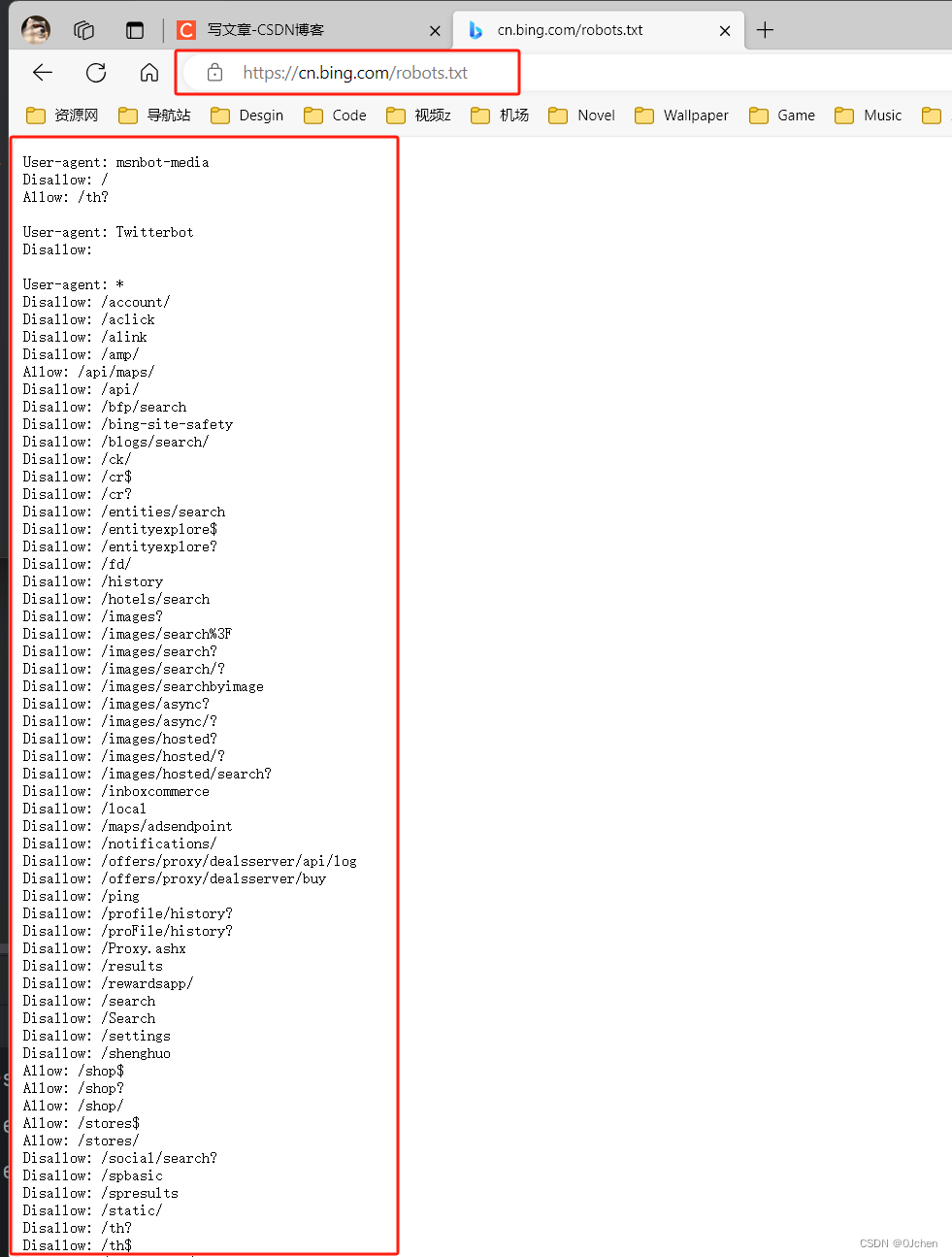文章目录
一、什么是爬虫?
爬虫就是程序从互联网中各个网站上爬取数据,做数据清洗再入库。
本质原理
从技术层面来说就是:通过程序模拟浏览器请求站点的行为,把站点返回的HTML代码/JSON数据/二进制数据(图片、视频等)爬取到本地,进而提取自己需要的数据,存放起来使用
通俗的说就是:通过模拟发送http请求从而去别人的服务端获取数据,然后把获取的数据入库
爬虫是否合法?
爬虫有爬虫协议
(是一个君子协议):每个网站根路径下都有robots.txt,这个文件规定了该网站,哪些可以爬取,哪些不能爬取

二、爬虫基本流程
用户获取网络数据的方式:
- 方式1:浏览器提交请求—>下载网页代码—>解析成页面
- 方式2:模拟浏览器发送请求(获取网页代码)—>提取有用的数据—>存放到数据库或文件中
而爬虫就是使用 方式2来实现的

1.发起请求(模拟发送http请求)
使用http库向目标站点发送请求,即发送一个request请求
request包含:请求头、请求体等
需要使用到爬虫模块
1.reqeusts模块
2.selenium
'网页反扒:封id:ip代理,封账号:cookie池'
2.获取响应内容
如果服务器能正常响应,则会得到一个Response
Response包含:html,json,图片,视频等
3.解析数据内容
解析html数据:正则表达式(RE模块),第三方解析库如Beautifulsoup,pyquery等
解析json数据:json模块
解析二进制数据:以wb的方式写入文件
4.保存数据(数据入库)
数据库(MySQL,Mongdb、Redis)
文件中
三、requests模块介绍
使用
python如何向网页发送http请求,本质是requests模块,封装了python内置模块urllib,使用requests可以模拟浏览器的请求(http),比起之前用到的urllib,requests模块的api更加便捷(本质就是封装了urllib3)
requests库发送请求将网页内容下载下来以后,并不会执行js代码,这需要我们自己分析目标站点然后发起新的request请求
安装reqeusts模块
pip install requests
四、requests模块发送Get请求
import requests
res = requests.get('https://www.cnblogs.com/')
# print(res) # <Response [200]>
print(res.text) # http响应体文本内容
'''如果有的网站,发送请求后,不返回数据或者拦截,这是别人做了反扒'''
# http请求:请求头中没带东西,没带cookie,客户端类型,referer....
res = requests.get('https://dig.chouti.com/')
print(res.text)
五、Get请求携带参数
import requests
'方式一:直接拼到路径中'
res = requests.get('https://www.baidu.com?info=jack')
print(res.url) # https://www.baidu.com/?info=jack
'方式二:使用params参数携带'
res = requests.get('https://www.baidu.com',params={'info':'jack','age':19})
print(res.url) #https://www.baidu.com/?info=jack&age=19
# print(res.text) # 响应体内容
URL编码与解码
'从地址栏里拿出数据 都会被URL进行编码和解码'
from urllib.parse import quote,unquote # 内置模块
info = quote('上海') # 编码
print(info) # %E4%B8%8A%E6%B5%B7
info1 = unquote('%E4%B8%8A%E6%B5%B7') # 解码
print(info1) # 上海
六、携带请求头
http请求中,请求头中有一个很重要的参数 :
User-Agent,如果向后端发送请求没有带这个请求头,后端就禁止访问。大多网站没有携带该参数就被禁止了。
用户代理(User Agent,简称 UA),是一个特殊字符串头,使得服务器能够识别客户使用的操作系统及版本、CPU 类型、浏览器及版本、浏览器渲染引擎、浏览器语言、浏览器插件等。
import requests
headers = {
'User-Agent':'Mozilla/5.0 (Windows NT 10.0; Win64; x64) AppleWebKit/537.36 (KHTML, like Gecko) Chrome/121.0.0.0 Safari/537.36'
}
res = requests.get('https://dig.chouti.com/',headers=headers)
'''
def request(method, url, **kwargs):
:param headers: (optional) Dictionary of HTTP Headers to send with the :class:`Request`.
'''
print(res.text)
'User-Agent:客户端类型:有浏览器、手机端浏览器、爬虫类型,程序,scrapy一般伪造成浏览器'
我们去爬某个网站,发送请求不能正常返回数据,说明模拟的不够像,需要携带参数,只要参数对应上就能返回相应的数据。
一般网站可以通过Referer来做反扒如果要登录,模拟向登录接口发请求,正常操作必须在登录页面上才能干这事。如果没有携带referer,它就认为你是恶意的就会拒绝。
七、发送post请求
import requests
headers = {
'User-Agent':'Mozilla/5.0 (Windows NT 10.0; Win64; x64) AppleWebKit/537.36 (KHTML, like Gecko) Chrome/121.0.0.0 Safari/537.36',
'Cookie':'iJ9flkdsjaxxxx=...'
}
data = {'linkId':'41569712',} # 发送请求携带的文章id
res = requests.post('https://dig.chouti.com/link/vote',headers=headers,data=data)
print(res.text) # {"data":4,"code":200,"success":true}
八、携带cookie
方式一:放在请求头中
'模拟抽屉网点赞信息'
import requests
'''
是否登录---》有个标志
1 前后端混合项目---》登录信息-->放在cookie中了
2 前后端分离项目---》登录信息--》后端规定的--》放在请求头的
'''
headers = {
'User-Agent':'Mozilla/5.0 (Windows NT 10.0; Win64; x64) AppleWebKit/537.36 (KHTML, like Gecko) Chrome/121.0.0.0 Safari/537.36',
'Cookie':'deviceId=web.eyJ0eXAiOiJKV1QiLCJhbGciOiJIUzI1NiJ9flkdsjaxxxx=...'
}
data = {'linkId':'41569712',} # 发送请求携带的文章id
res = requests.post('https://dig.chouti.com/link/vote',headers=headers,data=data)
print(res.text) # {"data":4,"code":200,"success":true}
方式二:放在cookie参数中
通过cookie参数:因为cookie很特殊,一般都需要携带,模块把cookie单独抽取成一个参数,是字典类型,以后可以通过参数传入
headers = {
'User-Agent':'Mozilla/5.0 (Windows NT 10.0; Win64; x64) AppleWebKit/537.36 (KHTML, like Gecko) Chrome/121.0.0.0 Safari/537.36',
}
data = {'linkId':'41569712',} # 发送请求携带的文章id
cookie = {
'token':'eyJ0eXAiOiJKV1QiLCJhbGciOiJIUzI1NiJ9xxxxx'
} # cookies格式都是字典格式 按照输入即可
res = requests.post('https://dig.chouti.com/link/vote',headers=headers,data=data,cookies=cookie)
print(res.text) # {"data":5,"code":200,"success":true}
九、post请求携带参数
import requests
'''post请求:三种编码方式:json、Urlencoded、form-data'''
'方式一:data参数'
# 咱们以data字典形式携带,它使用的Urlencoded编码,最终编码为name=jack&age=19,然后放在请求体中
':param data: (optional) Dictionary, list of tuples, bytes, or file-like'
\res = requests.post('地址',data={'name':'jack','age':19})
# res = requests.post('地址',data=b'name=jack&age=19')
'方式二:json编码'
# 咱们以json字典形式携带,它使用的json编码,最终编码为{'name':'jack','age':19},然后放在请求体中
':param json: (optional) A JSON serializable Python object to send in the body of the :class:`Request`'
res = requests.post('地址',json={'name':'jack','age':19})
十、模拟登录
方式一
先发送错误登录请求 看返回数据是否对错 输入对的密码 获取cookie 通过Cookie登录
import requests
data = {
'username': 'jack',
'password': '123',
'captcha': '111',
'remember': '1',
'ref': 'http://www.aa7a.cn/', # 登录成功重定向到这个地址
'act': 'act_login'
}
res = requests.post('http://www.aa7a.cn/user.php',data=data)
print(res.text) # {"error":5}
print(res.cookies) # RequestsCookieJar对象响应头中得cookie,如果正常登录,这个cookie,就是登录后的cookie
res1 = requests.get('http://www.aa7a.cn/',cookies=res.cookies) # 访问首页,携带cookie
print('jack' in res.text)
方式二
data = {
'username': 'xxxxx',
'password': 'xxxxx', # 错误的 请求码是 error 5 正确的是0
'captcha': 'cccc',
'remember': 1,
'ref': 'http://www.aa7a.cn/',
'act': 'act_login'
}
res = requests.post('http://www.aa7a.cn/user.php', json= {"key": "Value"})
十一、session对象
# http 请求,每次都是一个新的---》cookie需要自己处理携带
# session可以自动处理cookie,不需要手动携带了
import requests
session=requests.session()
data = {
'username': 'jack',
'password': '123',
'captcha': '111',
'remember': '1',
'ref': 'http://www.aa7a.cn/', # 登录成功重定向到这个地址
'act': 'act_login'
}
res = session.post('http://www.aa7a.cn/user.php',data=data)
print(res.text) # {"error":5}
'使用session对象,就无需在请求中携带cookie,会自动携带'
res1 = session.get('http://www.aa7a.cn/') # 自动保持登录状态,自动携带cookie
print('jack' in res.text)
十二、响应response对象
使用requests模块
1.发送请求:request对象:请求头,请求参数,请求体---》本质就是http请求--》被包装成一个对象
2.响应回来:response对象:http响应--》cookie,响应头,响应体。。
import requests
# response对象有很多属性和方法
headers={
'User-Agent':'Mozilla/5.0 (Windows NT 10.0; Win64; x64) AppleWebKit/537.36 (KHTML, like Gecko) Chrome/121.0.0.0 Safari/537.36'
}
respone = requests.get('https://www.jianshu.com/',headers=headers)
# respone属性
print(respone.text) # 响应体的文本内容
print(respone.content) # 响应体的二进制内容
print(respone.status_code) # 响应状态码
print(respone.headers) # 响应头
print(respone.cookies) # 响应cookie
print(respone.cookies.get_dict()) # cookieJar对象,获得到真正的字段
print(respone.cookies.items()) # 获得cookie的所有key和value值
print(respone.url) # 请求地址
print(respone.history) # 访问这个地址,可能会重定向,放了它重定向的地址
print(respone.encoding) # 页面编码
'''
# 有的网站,打印
res.text --->发现乱码---》请求回来的二进制---》转成了字符串---》默认用utf8转---》
response.encoding='gbk'
再打印res.text它就用gbk转码
'''
十三、下载图片
1.没有带图片防盗链的图片地址
res = requests.get('https://img.zcool.cn/community/0186025d143ecaa8012051cd9c2eb7.jpg@1280w_1l_2o_100sh.jpg')
res = requests.get('https://pic.3gbizhi.com/uploads/20210611/a070a0d807c9042c9d123597d83797f0.jpg')
res = requests.get('https://c-ssl.dtstatic.com/uploads/blog/202311/01/wgSLoQZi9oAPeg.thumb.1000_0.jpeg')
# print(res.content)
with open('feng.jpg','wb') as f:
f.write(res.content)
with open('chognwu.jpg', 'wb') as f:
for line in res.iter_content(chunk_size=1024):
f.write(line)
2.带有图片防盗链的图片地址
'以上是没有带图片防盗链的,如果到了图片防盗链,需要在请求头中添加一个referer参数,里面写的是上次访问的地址'
headers = {
'Referer':'https://www.tupianzj.com/'
}
res = requests.get('https://img.lianzhixiu.com/uploads/allimg/220223/9-220223141210-51.jpg',headers=headers)
with open('ju.jpg','wb') as f:
for line in res.iter_content():
f.write(line)

获取视频的操作同上面一样
十四、ssl认证
http协议
HTTP协议以明文方式发送内容,不提供任何方式的数据加密。HTTP协议不适合传输一些敏感信息
https协议:http+ssl/tsl
https则是具有安全性的ssl加密传输协议。HTTP+ SSL / TLS,也就是在 http上又加了一层处理加密信息的模块,比 http安全,可防止数据在传输过程中被窃取、改变,确保数据的完整性
http版本区别
0.9:底层基于tcp,每次http请求,都是建立一个tcp连接,三次握手,请求结束需要四次挥手
1.1:请求头中有个参数Keep-alive,可以保证多个http请求公用一个TCP连接
2.x:多路复用,多个请求使用同一个数据包
-请求协议:
请求首行:请求头地址,请求方式,http的版本
请求头:key-value
请求体
-响应协议:
响应首行:响应状态码,响应字符串描述
响应头:key-vaule,响应状态码,cookie
响应体
'简单了解:https比http多了ssl和tls协议,多了一层处理加密信息的模块。'
解决证书提示错误问题
1.不验证证书—加入verify=False
import requests
respone=requests.get('https://www.12306.cn',verify=False) #不验证证书,报警告,返回200
print(respone.status_code) # 200
2.关闭警告
import requests
from requests.packages import urllib3
urllib3.disable_warnings() #关闭警告
respone=requests.get('https://www.12306.cn',verify=False)
print(respone.status_code)
3.手动携带证书-了解
import requests
respone=requests.get('https://www.12306.cn',
cert=('/path/server.crt',
'/path/key'))
print(respone.status_code)
十五、超时设置,异常处理,上传文件
import requests
1.超时设置
# res = requests.get('https://www.baidu.com/',timeout=0.0001)
# print(res.text)
2.异常处理
from requests.exceptions import * #可以查看requests.exceptions获取异常类型
try:
r=requests.get('https://www.baidu.com',timeout=0.0001)
except ReadTimeout:
print('--------')
# except ConnectionError: #网络不通
# print('-----')
# except Timeout:
# print('aaaaa')
except RequestException: # 通用方案
print('Error')
3.上传文件
files={'file':open('ju.jpg','rb')}
respone=requests.post('http://httpbin.org/post',files=files)
print(respone.status_code)
十六、使用代理
免费代理池:https://github.com/jhao104/proxy_pool
'原理:有些网站提供免费的代理--》爬虫技术---》爬取别人的免费代理--》验证过后---》自己用'
import requests
res = requests.get('http://demo.spiderpy.cn/get/?type=https')
print(res.json())
print(res.json()['proxy'])
# 111.177.63.86:8888
headers={
'User-Agent':'Mozilla/5.0 (Windows NT 10.0; Win64; x64) AppleWebKit/537.36 (KHTML, like Gecko) Chrome/121.0.0.0 Safari/537.36'
}
respone = requests.get('https://www.jianshu.com/',headers=headers,proxies={'https':res.json()['proxy']})
print(respone.text)





















 2423
2423











 被折叠的 条评论
为什么被折叠?
被折叠的 条评论
为什么被折叠?








